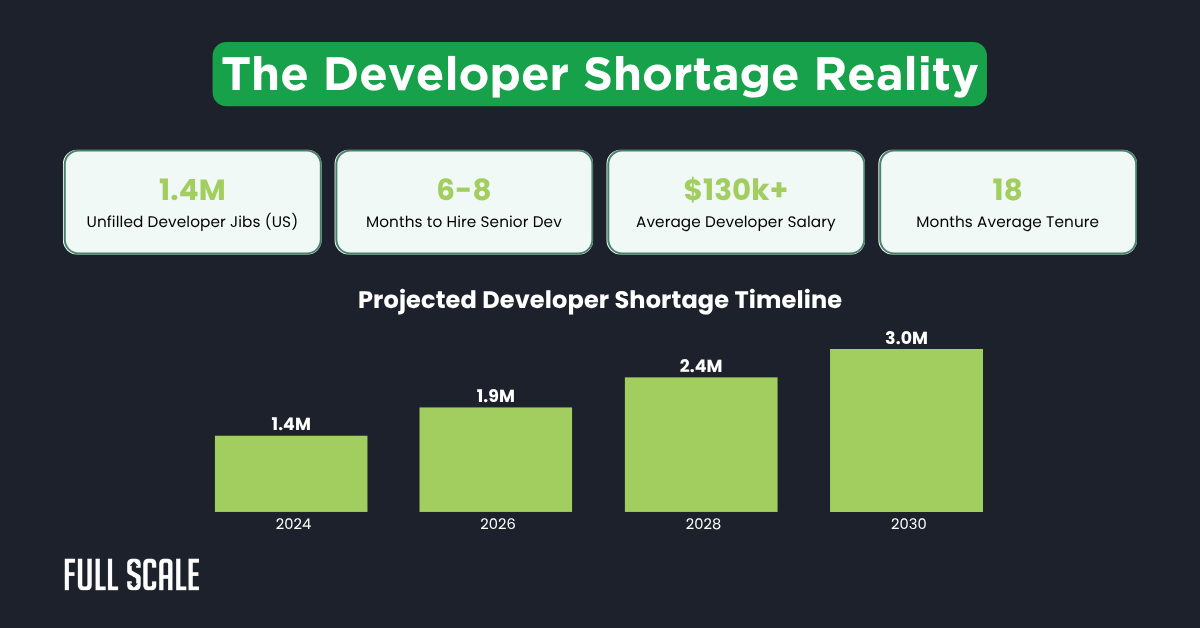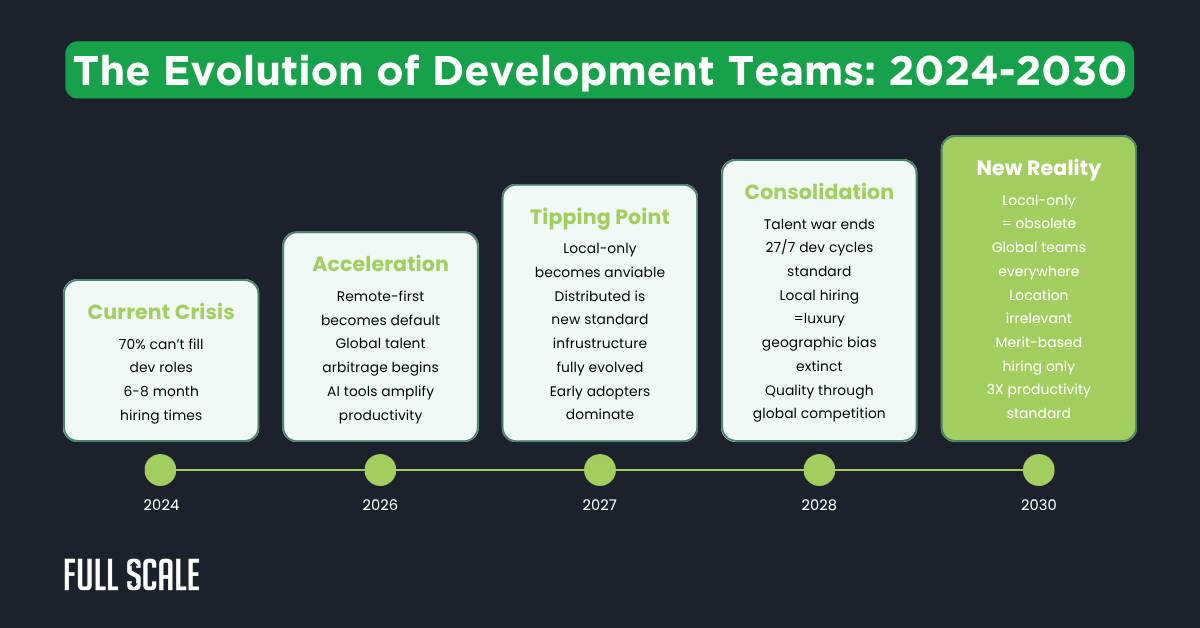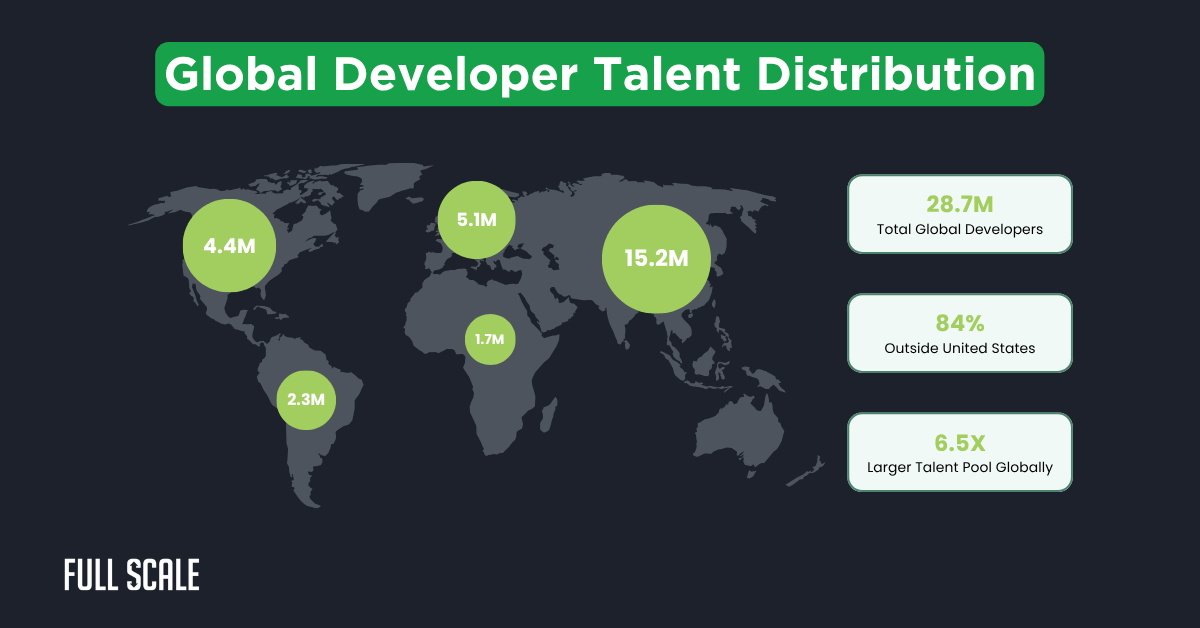Last Updated on 2025-08-26
The future of software development teams isn’t coming—it’s already here. By 2030, companies clinging to local-only hiring will be as outdated as dial-up internet. The data doesn’t lie: we’re watching the death of geographic limitations in real time.
Here’s what we’ll cover in this analysis:
- Why 70% of tech companies can’t fill developer roles locally anymore
- How the global talent pool will reshape software development by 2027
- The exact timeline of when local-only hiring becomes impossible
- What CTOs must do today to avoid extinction tomorrow
- Why early adopters of global teams already have an insurmountable advantage
What Is the Future of Software Development Teams?
The future of software development teams is distributed, global, and completely disconnected from geography. Within five years, successful tech companies will source talent from a global pool of 28.7 million developers.
Local-only teams will struggle to compete against companies operating 24/7 development cycles across multiple time zones.
I learned this the hard way, building my own companies. We burned through $400K trying to hire locally in Kansas City. Six months of recruiting, and we found exactly two qualified developers.
The Current State: Why Local Teams Are Already Failing
Right now, 70% of US tech companies can’t fill critical developer roles locally. The math is brutal and getting worse every quarter. Trust me, I’ve been on both sides of this disaster.

This visualization shows the accelerating developer shortage crisis. The gap between demand and local supply doubles by 2030.
Local development teams face four crushing realities today. Each one gets worse as competition for scarce talent intensifies. I’ve experienced every single one of these firsthand.
The Talent Desert
According to the U.S. Bureau of Labor Statistics, we need 1.4 million more developers than we have. Local talent pools are bone dry in most cities. Companies waste months searching for developers who don’t exist in their zip code.
The Cost Death Spiral
Average developer salaries jumped 23% since 2020 (Stack Overflow Developer Survey 2024). Senior developers in San Francisco now command $180K+ base salaries. Mid-market companies can’t compete with tech giant compensation packages anymore.
The Speed Problem
Hiring a qualified senior developer takes 6-8 months on average. That’s half a year of lost productivity and missed deadlines. Your competitors with distributed engineering teams are shipping features while you’re still interviewing.
The Retention Joke
Developers stay an average of 18 months before chasing the next raise. You spend six months hiring and six months onboarding. They contribute for six months, then leave for 20% more somewhere else.
These problems compound daily, pushing the future of software development teams toward an inevitable conclusion. Local-only strategies are already dead—most companies just haven’t realized it yet.
The Acceleration Phase: What Happens Next (2025-2027)
The shift from local to distributed software development will accelerate dramatically over the next three years. Smart companies are already positioning themselves for this reality. The rest will scramble to catch up when it’s too late.
Remote development teams become the standard, not the exception. Geographic boundaries dissolve as results matter more than locations. This isn’t some remote-work fantasy—it’s basic supply and demand economics.

This timeline shows the inevitable progression from today’s hiring crisis to tomorrow’s global reality. Each phase builds on the previous, creating unstoppable momentum toward distributed teams.
Remote-First Becomes Remote-Only
Companies abandoning office requirements see immediate talent pool expansion. The best developers work where they want, when they want. Fighting this trend means losing access to 95% of the global talent pool of developers.
The Global Talent Arbitrage
There are 28.7 million developers worldwide (Evans Data Corporation, 2024). Only 4.4 million work in the United States. Companies tapping international talent get better developers at sustainable costs.

This map reveals the massive untapped developer talent outside traditional tech hubs. Companies limiting themselves to local hiring access only 15% of the available talent.
AI-Assisted Development
AI tools amplify what distributed software development teams can deliver. Code review, testing, and documentation happen faster across time zones. The productivity gap between local and global teams disappears completely.
The Death of Geographic Bias
Results matter more than zip codes in the future of software development teams. Clients care about shipped features, not developer addresses. The best code wins, regardless of where it’s written.
What surprises most CTOs is that remote-first engineering actually improves code quality. Without office distractions, developers focus on what matters—shipping great software. The future of software development teams prioritizes output over office attendance.
The Tipping Point: When Everything Changes (2027-2028)
The transformation reaches critical mass as early adopters dominate their industries. Local-only companies scramble to catch up but find themselves years behind. The software team trends of 2030 will look back at this period as the turning point.
Market forces make distributed engineering teams the only viable option. The economics become impossible to ignore. Even the most stubborn “butts-in-seats” executives finally accept reality.
| Metric | Local Teams | Global Teams | Advantage |
| Time to Hire | 6-8 months | 2-4 weeks | 8X faster |
| Talent Pool | 50K (city) | 28.7M (global) | 574X larger |
| Average Cost | $130K-180K | $40K-80K | 60% savings |
| Retention Rate | 18 months | 3+ years | 2X longer |
| Productivity | 8 hours/day | 24 hours/day | 3X output |
This comparison shows why local-only strategies become competitively impossible. The advantages of global teams compound over time.
The Talent War Ends
Companies with established global development teams stop competing for local talent entirely. They’ve already won by changing the game completely. Local-only companies fight over scraps while global companies choose from millions.
New Standard Operating Model
Distributed becomes the default operating model for software companies. Tools, processes, and management practices evolve for remote-first environments. Local hiring becomes a luxury only the most profitable companies can afford.
Infrastructure Evolution
Every tool and platform optimizes for distributed team collaboration. Async communication, automated workflows, and AI-powered coordination become standard. The friction of managing remote development teams disappears entirely.
This isn’t theoretical—I see it happening with our clients daily. The future of software development teams belongs to those who embrace this shift now. Companies waiting for “proof” will find themselves priced out of the talent market.
The New Reality: Future of Software Development Teams in 2030
By 2030, the transformation complete itself across the industry. Local-only development teams exist only in legacy organizations resisting change. The entire software industry reorganizes around global talent access.
Geographic limitations seem as quaint as requiring developers to work on mainframes. The future of software development teams operates on a completely different paradigm. Location becomes irrelevant to team composition and success.
Development Team Cost Calculator
Development Team Cost Comparison
This calculator demonstrates the economic reality driving the shift. Companies save 60-75% on development costs while accessing better talent globally.
Local Teams Equal Competitive Disadvantage
Companies limiting themselves to local talent operate with one hand tied. They pay more for less talent with higher turnover. Their competitors ship faster, iterate quicker, and scale without geographic constraints.
The 24-Hour Development Cycle
Follow-the-sun development becomes standard practice for competitive companies. Code gets written, reviewed, and deployed around the clock. Features that took weeks now ship in days through continuous development.
Quality Through Global Competition
The best developers win projects regardless of location or timezone. Merit-based hiring replaces proximity-based settling for available talent. Code quality improves as companies choose from millions instead of hundreds.
The End of Offshore Stigma
The term “offshore development” disappears from professional vocabulary entirely. It’s just “your team” working together toward shared goals. Location becomes as irrelevant as which IDE developers prefer.
Let me be blunt: companies still debating remote work in 2025 are already obsolete. The future of software development teams doesn’t care about your office lease. It cares about shipping great software with the best talent available globally.
What This Means for Tech Leaders Today
CTOs and VPs of Engineering face a critical decision point right now. The choices made today determine competitive positioning for the next decade. Wait too long, and you’ll never catch up.
Early adopters of distributed engineering teams already report dramatic improvements. Late adopters will spend years trying to catch up. The gap widens daily between forward-thinking companies and those clinging to outdated models.
Start Now or Get Left Behind
Companies building global capabilities today will dominate their markets tomorrow. The learning curve for managing distributed teams takes time to master. Starting in 2025 means being ready when the shift completes.
The Skills That Matter
Managing the future of software development teams requires different leadership skills than local teams. Async communication, cultural awareness, and results-based management become core competencies. Leaders who master these skills become invaluable to their organizations.
Infrastructure Investment
Tools, processes, and culture must evolve for distributed team success. This isn’t about buying Slack licenses and hoping for the best. It requires fundamental rethinking of how teams collaborate and deliver value.
The First-Mover Advantage
Companies already operating with global teams report 3x faster scaling capabilities. They’re not competing for the same scarce local talent anymore. They’re building world-class teams while others argue about return-to-office policies.
I’ve watched companies transform their entire trajectory by embracing this shift early. Those waiting for “perfect timing” will find the talent market has moved on without them. The future of software development teams rewards decisive action over cautious planning.
How Full Scale Built Tomorrow’s Development Model Today
While others debate the future of offshore software development, we’ve already built it. Full Scale operates the exact model that will dominate the industry by 2030. Here’s why we’re the perfect partner for your global development team:
- Direct Integration, Not Outsourcing – Your developers work directly with you, fully embedded in your workflows. No project managers as middlemen, no communication barriers, just seamless collaboration.
- 95%+ Developer Retention – We treat developers as long-term employees with benefits, career growth, and respect. Happy developers don’t leave for 10% raises.
- 2-4 Week Hiring Timeline – Access pre-vetted senior developers ready to start immediately. We’ve already done the hard work of finding and qualifying top talent.
- US-Based Contracts & IP Protection – Full legal protection with American contracts and intellectual property safeguards. All the benefits of global talent with none of the risks.
- Proven Track Record – Over 200 companies already use Full Scale to build world-class development teams. We’ve refined the distributed model through years of real-world experience.
The companies winning in 2030 are building their global teams today. Don’t wait for the future—start building your competitive advantage now. The future of software development teams belongs to those who act today.
The Bottom Line: Adapt or Become Irrelevant
The future of software development teams is distributed, integrated, and global. This isn’t speculation based on remote work trends. It’s a mathematical certainty based on talent supply and demand fundamentals.
Here’s what smart CTOs already know:
- Local-only hiring strategies are failing right now, not in some distant future
- The talent shortage will double by 2030, making local hiring mathematically impossible
- Companies building global teams today will dominate those starting in 2027
- The infrastructure for distributed teams already exists—waiting means falling behind
- Your competitors are already making this shift while you debate office policies
Companies clinging to geographic limitations will become the Blockbusters of software development. They’ll wonder why they can’t compete while refusing to evolve. Don’t let nostalgia for “how things used to work” destroy your company’s future.
Remember when everyone said cloud computing was “just a trend”? The same people are saying that about distributed teams today. We all know how that story ends.
Build Your Global Development Team Today
FAQs: The Future of Software Development Teams
What will development teams look like in 2030?
Development teams in 2030 will be globally distributed, working asynchronously across time zones. They’ll use AI-powered tools for coordination and operate without geographic constraints. Local offices will be optional collaboration spaces, not requirements. The future of software development teams eliminates location as a hiring factor.
When will local development teams end?
The end of local development teams is happening now, not in the future. By 2027-2028, local-only hiring will be competitively impossible. Companies still pursuing this strategy in 2030 will be acquisition targets or out of business. Smart companies are already transitioning to distributed engineering teams.
How will software teams work in the future?
The future of software development teams operates on continuous development cycles across global talent pools. Teams collaborate through advanced async tools, AI-assisted coding, and results-based performance metrics. Physical location becomes completely irrelevant to team success. Companies access the best developers worldwide, not just within commuting distance.
Why are companies switching to global development teams now?
Companies switch because local hiring takes 6-8 months while global hiring takes 2-4 weeks. They save 60-75% on development costs while accessing 574X more talent. The future of software development teams favors speed, quality, and cost efficiency over geographic proximity.
What skills do CTOs need for managing distributed teams?
CTOs managing the future of software development teams need async communication mastery, cultural intelligence, and results-based leadership skills. They must understand global talent markets, distributed collaboration tools, and performance management across time zones. Traditional “management by walking around” becomes obsolete.

Matt Watson is a serial tech entrepreneur who has started four companies and had a nine-figure exit. He was the founder and CTO of VinSolutions, the #1 CRM software used in today’s automotive industry. He has over twenty years of experience working as a tech CTO and building cutting-edge SaaS solutions.
As the CEO of Full Scale, he has helped over 100 tech companies build their software services and development teams. Full Scale specializes in helping tech companies grow by augmenting their in-house teams with software development talent from the Philippines.
Matt hosts Startup Hustle, a top podcast about entrepreneurship with over 6 million downloads. He has a wealth of knowledge about startups and business from his personal experience and from interviewing hundreds of other entrepreneurs.




